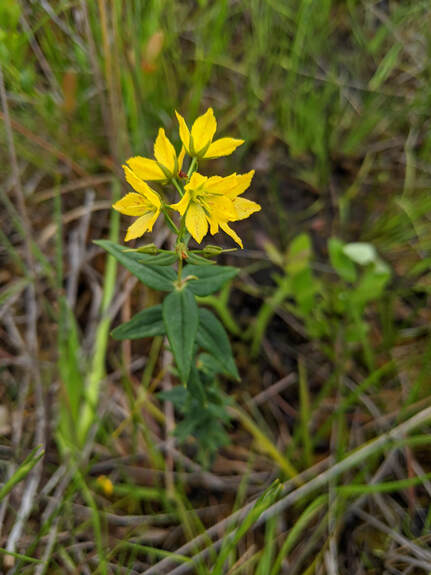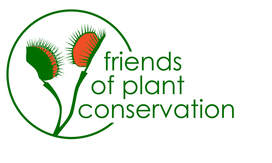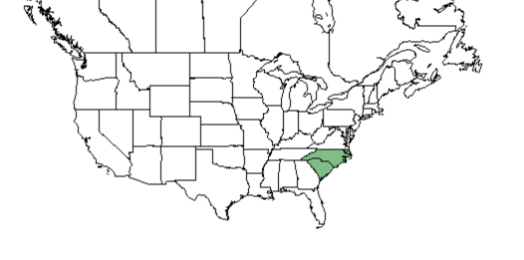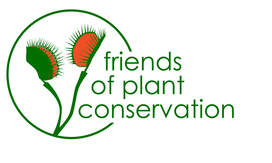Rough-leaf Loosestrife
Lysimachia asperulifolia
Primulaceae Family

Description
Rough-leaf loosestrife is a perennial herb that grows 11.8 – 23.6 inches (in) (30 - 60 centimeters; cm) tall. The triangular shaped leaves are often opposite on shorter stems (less than 30 cm tall) and tend to be arranged in whorls of three or four encircling taller stems. The leaves are widest at the base (0.3 – 0.8 in or 0.8 - 2.0 cm wide) and have three prominent veins. Contrary to the common name, the leaf surfaces are smooth to the touch. The yellow flowers are 0.6 (1.5 cm) across with yellow-orange anthers and occur on terminal racemes that are 1.2 – 3.9 in (3 - 10 cm) long. Flowering occurs from mid-May through June, with fruits (capsules) present from July through October. Since only a few stems in each population flower in any given year, surveyors should look for the leaves rather than yellow flowers. Stipitate glands are usually present on most parts of the plant. This species is easily distinguished from Loomis’ yellow loosestrife (Lysimachia loomisii) a similar southeastern species by its broader, glandular leaves and much larger flowers. https://www.fws.gov/raleigh/species/es_rough-leaf_loosestrife.html
Distribution & Habitat
The North Carolina Natural Heritage Program lists Rough-leaf Loosestrife as vulnerable (S3) due to its restricted range across 15 coastal counties (Beaufort, Bladen, Brunswick, Carteret, Columbus, Craven, Cumberland, Harnett, Hoke, New Hanover, Onslow, Pamlico, Pender, Richmond, Scotland). It is specialized in the ecotone between savannas and pocosin. Reproduction occurs by rhizomes which restricts its ability to spread beyond established populations.
Threats
Fire suppression, firebreak installation, and habitat destruction from road construction, residential development, and agricultural conversion
Preservation Efforts
Controlled burns, restrictions on human activity in existing habitats, seedbanking, and reintroduction of the species to its historic habitat
Rough-leaf loosestrife is a perennial herb that grows 11.8 – 23.6 inches (in) (30 - 60 centimeters; cm) tall. The triangular shaped leaves are often opposite on shorter stems (less than 30 cm tall) and tend to be arranged in whorls of three or four encircling taller stems. The leaves are widest at the base (0.3 – 0.8 in or 0.8 - 2.0 cm wide) and have three prominent veins. Contrary to the common name, the leaf surfaces are smooth to the touch. The yellow flowers are 0.6 (1.5 cm) across with yellow-orange anthers and occur on terminal racemes that are 1.2 – 3.9 in (3 - 10 cm) long. Flowering occurs from mid-May through June, with fruits (capsules) present from July through October. Since only a few stems in each population flower in any given year, surveyors should look for the leaves rather than yellow flowers. Stipitate glands are usually present on most parts of the plant. This species is easily distinguished from Loomis’ yellow loosestrife (Lysimachia loomisii) a similar southeastern species by its broader, glandular leaves and much larger flowers. https://www.fws.gov/raleigh/species/es_rough-leaf_loosestrife.html
Distribution & Habitat
The North Carolina Natural Heritage Program lists Rough-leaf Loosestrife as vulnerable (S3) due to its restricted range across 15 coastal counties (Beaufort, Bladen, Brunswick, Carteret, Columbus, Craven, Cumberland, Harnett, Hoke, New Hanover, Onslow, Pamlico, Pender, Richmond, Scotland). It is specialized in the ecotone between savannas and pocosin. Reproduction occurs by rhizomes which restricts its ability to spread beyond established populations.
Threats
Fire suppression, firebreak installation, and habitat destruction from road construction, residential development, and agricultural conversion
Preservation Efforts
Controlled burns, restrictions on human activity in existing habitats, seedbanking, and reintroduction of the species to its historic habitat


